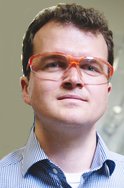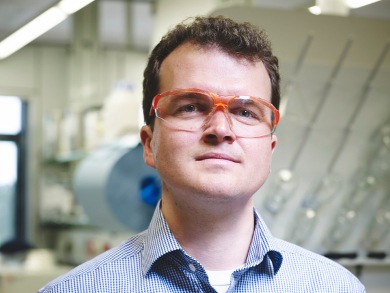Dr. Marc Fricke, laboratory head for Advanced Materials & Systems Research, BASF Polyurethanes GmbH, Lemförde, Germany, has developed together with his team a novel type of aerogel that will be offered as an extremely thin and mechanically strong insulating panel. It shows exceptional insulation performance, is light, has moisture-regulation performance, and will be produced as an aerogel panel that is easy to apply.
What kind of material is the new insulation panel made of?
The material is an organic aerogel based on polyurethane chemistry that shows an interesting combination of properties. This includes not only very low thermal conductivity – the λ value is quite low – but in addition it is a strong panel, and it is water vapor diffusive. Owing to its open-porous structure, it can absorb water or water vapor condensates within the nanopores, and it can release the water again. This makes it especially interesting for construction materials, especially for insulation applications. We can fine-tune the properties by using its chemistry.
And you are going to present this at the aerogel workshop at the TU Harburg?
Yes, I am looking forward to the academic discussion during this workshop organized by Professor Smirnova where the who’s who of the chemical as well as the process engineering aerogel community will meet.
We have learned that organic aerogels are the main topic within this community now. So inorganic, mainly silica-based aerogels are well-known, though still interesting; but a lot has already been done. Many groups worked on that and are still working within that field. Now, however, there is a shift toward organic aerogels, meaning polyurethane-based, polyamine-based, and also to polysaccharides and to bio-based materials in general. So this is rather interesting.
Have silica-based aerogels been used as insulation materials as well?
There are insulation materials with nanopores based on silica-based aerogels in the market. These come as powders, granulates, or blankets that can be further processed to boards. Our organic polyurethane-based aerogels are solid panels and are very easy to handle.
So what are your next steps to get these insulating panels on the market?
This will take some more time. However, we will start a research pilot next year. The pilot plant is necessary to define process conditions for the upscaling.
Can you say something about the history of this project? When did research start?
More than seven years ago it started with general research on nanoporous foams. We called them nanofoams at the time. The idea was to design monolithic nanoporous materials. For this we had to develop new chemical concepts, so we tried different types in parallel, and characterized the resulting materials.
Now we are concentrating on polyurethane chemistry. We have explored a new chemistry to gain the desired properties. In recent years we have fine-tuned the chemistry.
And were you involved from the beginning?
Yes, more or less.
Was it always clear that it would be a successful project?
During the research stage it was not always clear. We started at the postdoc center at the Institut de Science et d’Ingénierie Supramoléculaires (ISIS) in Strasbourg. Jean-Marie Lehn headed this institute for supramolecular chemistry. The main idea of BASF was to put some postdocs from all over the world in one lab and that they should be able to do research with enough resources on highly risky topics – first to develop a concept out of the box or to look at existing concepts and transfer them to our problem. At a certain point we had to start a BASF-funded project with a business unit behind it and also to discuss the market potential, to discuss the right direction in terms of market size and application.
It was not clear that we would be successful in terms of material development at first, but over time it became obvious.
What was most interesting for you during the whole process?
Everything is new with respect to the whole project. I mean, in the first place, the chemistry as such. And it is also interesting to work in the field of highly insulating materials, or high-performance insulating materials, as we call them. This is an important field in terms of energy efficiency. There is a lot of discussion going on about whether we should use panel insulating materials as we do. This material could help to overcome some problems that we have at the moment, such as the modernization of old buildings and interior finishing, or complex design ideas. However, it is a completely new product for the market and, of course, also for BASF. Even the business model has to be defined. So everything is new and that is very interesting.
I was involved in everything more or less right from the beginning. This was a challenge on the one hand, and on the other hand, it was exciting to be part of this development from the start.
Can you please tell us something about how your career has developed?
I started as a postdoc for BASF at ISIS in the group for supramolecular chemistry. BASF started its first postdoc center there. Now we have different postdoc centers all over the world; ISIS was more or less the starting point of this idea. In 2007 I moved to Lemförde, Germany. Usually we start as a lab leader in research at BASF with some technicians. Also in 2007 the BASF-funded project on SLENTITE started, and from that point on I was the lab leader for this development. And I still am.
Looking back it was very important to have one person constantly working on this project. This was only possible on a lab-leader level, because otherwise I could not develop the, let’s say, recipe further to meet the application requirements and at the same time lead the research project.
And who created the name SLENTITE?
The name was created in a joint effort by communication professionals and the SLENTITE experts. In the creative process both material characteristics as well as PR aspects had been considered to come up with a meaningful, yet easy recognizable brand name.
And one last question: What do you do in your spare time?
I have a son. He is six-and-a-half years old, and we play a lot of soccer.
Thank you for the interview.

Marc Fricke studied chemistry at the University of Bielefeld and Munich, both Germany, and the Weizmann Institute of Science in Rehovot, Israel. He earned his PhD in Inorganic Chemistry from the University of Bielefeld, Germany, in 2000. After a postdoc for BASF at the Institut de Science et d’Ingénierie Supramoléculaires (ISIS), Strasbourg, France, he joined BASF Polyurethanes GmbH, Lemförde, Germany, in 2007.
Currently he is laboratory head for Advanced Materials & Systems Research and responsible for the development of SLENTITE.
Also of interest:
- First Polyurethane Aerogel Panel,
ChemistryViews.org 2013.




